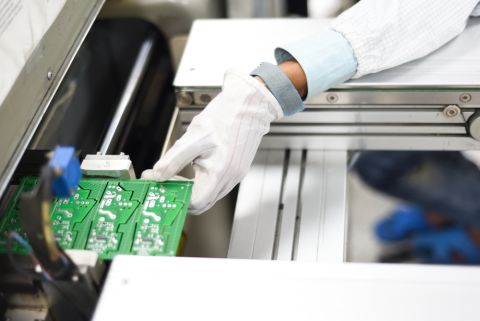Addressing the Semiconductor Supply Shortage: Chip Acts Heighten Awareness
The printed circuit board (PCB)—the carrier of mounted semiconductor components—and the semiconductor supply chain have a fascinating history, illustrating the remarkable trajectory of the electronics industry. Originating from the early 20th century and the mid-to-late-19th century, respectively, PCBs and semiconductors have revolutionized electronics by providing a compact, reliable, and cost-effective solution to connect electronic components and allow the flow of electric current within electronic devices.
Initially, production was primarily localized due to the relatively simple designs and the need for rapid prototyping; however, as electronics became more sophisticated and PCB designs more complex, manufacturers sought cost efficiencies, leading to the globalization of both the semiconductor and PCB supply chain. Asia, especially Taiwan and China, emerged as dominant players due to their lower production costs and integrated supply chains. Despite these advantages, the recent disruptions have highlighted the vulnerabilities in this global supply chain model, driving the re-evaluation of sourcing strategies and the pursuit of supplier diversification.
Ultimately, the global electronics industry has been grappling with a prolonged shortage of components—a situation that has been aggravated and exacerbated by a myriad of factors, such as supply chain disruptions, political disputes, and conflicts. This crisis has underscored the delicate balance and interdependency of global supply chains, prompting a global reckoning on the need for self-reliance and diversification of sources. The U.S. CHIPS and Science Act of 2022, the European Chips Act (ECA), and the Chip 4 Alliance represent significant efforts to address these challenges and are poised to reshape the landscape of semiconductor manufacturing, an industry vital to the 21st-century digital economy.
The United States ─ The CHIPS and Science Act of 2022
The CHIPS (Creating Helpful Incentives to Produce Semiconductors) and Science Act of 2022, a bipartisan legislation, was ratified by President Biden on August 9, 2022. The law authorizes a substantial fund of $280 billion to strengthen the domestic semiconductor industry by facilitating new manufacturing plant construction, bolstering research and development, and enhancing workforce skills.
Primarily, the CHIPS Act aims to mitigate the dependence of the United States on foreign entities for semiconductor procurement. At present, the U.S. imports approximately 90% of its semiconductors, which exposes the country to potential supply chain disruptions and other associated risks. By decreasing the reliance on international suppliers, the Act aims to enhance the country's competitiveness in the global economy.
This legislation signifies a major investment in the future trajectory of the U.S. semiconductor industry. It is projected to spur job creation within the industry and stimulate economic growth; it is also anticipated to augment national security by reducing dependency on foreign nations—and economic rivals—for essential technologies.
The CHIPS and Science Act is multifaceted, encompassing several crucial provisions, and is expected to secure domestic supply, create numerous construction and high-skilled manufacturing jobs, and stimulate hundreds of billions more in private investment. But to kick things off, the government anticipates that the Act will bolster U.S leadership in the semiconductor industry by allocating:
- $52.7 billion for U.S. semiconductor research and manufacturing.
- $39 billion in manufacturing incentives, with $2 billion specifically allocated for legacy chips used in automobiles and defense systems.
- $13.2 billion for R&D and workforce development.
- $500 million for international information communications technology security and semiconductor supply chain activities.
- A 25% investment tax credit for capital expenses related to semiconductor manufacturing and related equipment.
The North American Semiconductor Conference
In conjunction with the CHIPS Act, the U.S. administration has looked to improve collaboration with its neighbors and, in May 2023, launched the inaugural North American Semiconductor Conference with joint hosts Mexico and Canada.
Organized by the Semiconductor Industry Association (SIA) and Arizona State University, the conference assembled an array of government representatives, industry pioneers, and scholars for deliberations on the global economic significance of semiconductors and the formulation of strategies to consolidate the North American semiconductor supply chain.
Participants recognized the indispensable role of semiconductors in manufacturing a diverse array of products, encompassing automobiles, computers, and smartphones. They also acknowledged the vulnerability of the global semiconductor supply chain to disruptions, as exemplified by the COVID-19 pandemic and the conflict in Ukraine.
Addressing these challenges, the conference delegates resolved to collaborate toward fortifying the North American semiconductor supply chain. Their proposed measures included:
- Elevating investment levels in North American semiconductor manufacturing.
- Establishing fresh standards for semiconductors.
- Advocating for research and development in the semiconductor industry.
- Cultivating the forthcoming generation of semiconductor engineers.
Additionally, participants agreed to the formation of a North American Ministerial Committee on Economic Competitiveness. This committee is tasked with synchronizing the efforts of the three governments toward fortifying the North American semiconductor supply chain.
The initiation of the North American Semiconductor Conference signifies a constructive stride toward tackling the adversities faced by the global semiconductor industry. The dedication of conference participants toward a collaborative enhancement of the North American semiconductor supply chain is a crucial maneuver in guaranteeing a future secure supply of semiconductors globally and demonstrates a renewed dedication to ensuring the U.S.’s competitive standing in the global semiconductor market and reinforcing national security.
Europe ─ The European Chips Act (ECA)
On a smaller—but no less important—scale, the European Union Chips Act, proposed by the European Commission, is a comprehensive legislative measure designed to fortify the region's semiconductor industry at the cost of €43 billion. This proposed Act hinges on a tripartite structure:
- The first pillar takes aim at enhancing large-scale technological capacity and innovation within the EU's semiconductor sector. With the provision of financial support for new semiconductor manufacturing plants and research and development, this segment seeks to augment Europe's self-sufficiency in semiconductor production and diminish dependence on imports by, according to the European Commission, “facilitating the transfer of knowledge from the lab to the fab, bridging the gap between research and innovation and industrial activities by promoting the industrialization of innovative technologies by European businesses.”
- The second pillar seeks to bolster the EU's supply chain security, establishing protocols to assure a dependable semiconductor supply during crises. This could involve semiconductor stockpiling, supply source diversification, and fostering novel semiconductor production technologies.
- The third and final pillar envisages the creation of a monitoring and crisis response framework. This system would oversee the European semiconductor industry, detect potential risks, and strategize appropriate risk mitigation plans.
The European Chips Act represents a significant legislative venture with the potential to alter the landscape of Europe's semiconductor industry fundamentally. Successful implementation of the Act could propel Europe to a leading position in global semiconductor production, stimulate the European economy, and generate job opportunities for populations across the bloc.
Key projected benefits of the European Chips Act include:
- Augmented Self-reliance: By reducing reliance on semiconductor imports, the Act intends to enhance Europe's resilience against supply chain disruptions and other associated risks.
- Economic Expansion: The European Commission anticipates that the Act will catalyze job creation in the semiconductor industry, consequently stimulating the European economy.
- National Security: The Act strives to safeguard Europe's national security by diminishing dependency on foreign critical technologies.
Thus, the European Chips Act marks a significant stride toward revitalizing the European semiconductor sector. It sets the stage for Europe to emerge as a prominent player in global semiconductor production, thereby bolstering the economy and intracontinental collaboration for a brighter future.
The Act has undergone extensive scrutiny and negotiation across the last 15 months and is expected to be ratified by the European Parliament and the Council of the European Union in the near future. Post-adoption, the Act will be progressively implemented over several years as Europe looks to position itself as a dominant force in the chipmaking game.
Chip 4 Alliance
I should caveat this segment by stating that while it would make sense for the four major semiconductor-producing nations to collaborate in a team akin to the Avengers, the “Chip 4/Fab 4” Alliance has not yet been ratified, but senior officials have, according to Reuters, held their first meeting.
The Chip 4 Alliance, unofficially inaugurated in April 2022, is a collaborative endeavor among the United States, Japan, Taiwan, and South Korea. This initiative aims to fortify the global semiconductor supply chain in light of a global chip scarcity, which has affected production across numerous sectors, from automobiles to smartphones.
The objectives of the Chip 4 Alliance are threefold:
- Augmenting Semiconductor Production: The Alliance will foster increased semiconductor production within the four member nations. This will be achieved by attracting new investment in semiconductor manufacturing and encouraging the creation of innovative technologies that may reduce production costs.
- Fortifying the Global Semiconductor Supply Chain: The Alliance is committed to enhancing the resilience of the global semiconductor supply chain by minimizing dependence on any single nation for critical components. This objective involves promoting collaboration among the member nations in technology development and information sharing.
- Safeguarding Intellectual Property: A key focus of the Alliance is the protection of intellectual property rights within the semiconductor industry. This will be pursued through the establishment of novel policies and protocols to prevent intellectual property theft.
The Chip 4 Alliance, while still in its nascent stages, promises significant potential for positive influence on the global semiconductor supply chain.
If the nations involved can come to a consensus and successfully implement their plans, the Chip 4 Alliance is:
- poised to catalyze an increase in semiconductor production;
- set to consolidate the global semiconductor supply chain;
- ready to secure the intellectual property within the industry;
- on the verge of creating jobs, accelerating economic growth for nations involved, and advancing the global technology landscape.
In response to the global chip shortage, the Chip 4 Alliance symbolizes a progressive step toward ensuring a dependable future supply of semiconductors. Beyond its primary objectives, the Chip 4 Alliance also anticipates launching several other initiatives, including:
- Standardization within the semiconductor sector.
- The promotion of research and development in the semiconductor industry.
- Workforce development targeting future generations of semiconductor engineers.
As a comprehensive initiative, the Chip 4 Alliance is uniquely positioned to confront the global semiconductor industry’s challenges. Its expected impact on the global economy and its commitment to secure future semiconductor supplies reaffirm its integral role in a supply chain ecosystem that is growing increasingly turbulent and consequently unreliable.
In an ideal world, supply chain systems would run seamlessly, and resources would be in abundance; unfortunately, in reality, policymakers of leading nations must produce legislation to ensure stability and prosperity within the semiconductor industry as manufacturers and retailers attempt to overcome the precariousness that the powers that be have lumbered them with. The U.S. CHIPS and Science Act of 2022, the European Chips Act, and the Chip 4 Alliance are constructive measures poised to make substantial contributions to the PCB and semiconductor supply chain and the electronics market as a whole. By fostering technological innovation, increasing investment in manufacturing, and diminishing supply disruption risks, these initiatives are projected to influence the industry’s future landscape significantly.
As the electronic components industry continues to thrive, even during times of great adversity, there’s no better time for you—or your company—to take a look at Octopart’s world-leading electronic part search engine; with hundreds of component distributors and thousands of parts manufacturers, you’re sure to find everything you need for your PCB and semiconductor production needs.










